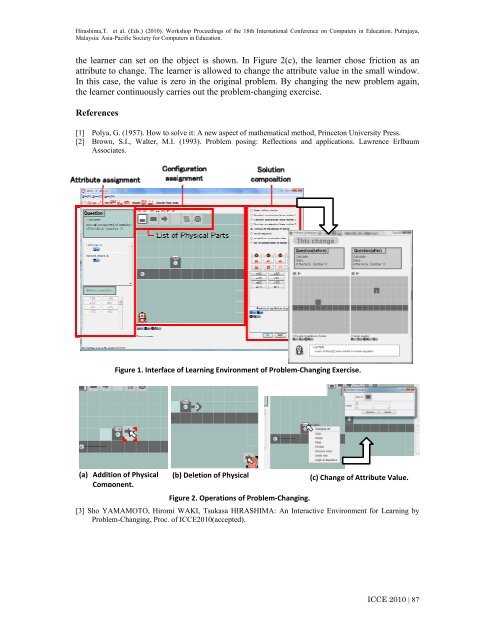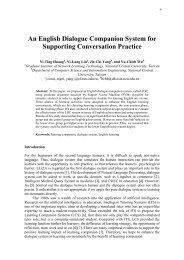- Page 2:
Workshop Proceedings of the 18th In
- Page 5:
Yung-Chi HSU Frank KAPPE Akihiro KA
- Page 12 and 13:
Weiqin Chen, University of Bergens,
- Page 16:
International Workshop on Models, M
- Page 25:
Hirashima,T. et al. (Eds.) (2010).
- Page 32 and 33:
Hirashima,T. et al. (Eds.) (2010).
- Page 34 and 35:
Hirashima,T. et al. (Eds.) (2010).
- Page 36:
Hirashima,T. et al. (Eds.) (2010).
- Page 40 and 41:
Hirashima,T. et al. (Eds.) (2010).
- Page 43 and 44:
Hirashima,T. et al. (Eds.) (2010).
- Page 45:
Hirashima,T. et al. (Eds.) (2010).
- Page 52:
Hirashima,T. et al. (Eds.) (2010).
- Page 55 and 56:
Hirashima,T. et al. (Eds.) (2010).
- Page 57: Hirashima,T. et al. (Eds.) (2010).
- Page 60 and 61: Hirashima,T. et al. (Eds.) (2010).
- Page 62 and 63: Hirashima,T. et al. (Eds.) (2010).
- Page 64 and 65: Hirashima,T. et al. (Eds.) (2010).
- Page 66 and 67: Hirashima,T. et al. (Eds.) (2010).
- Page 68 and 69: Hirashima,T. et al. (Eds.) (2010).
- Page 70 and 71: Hirashima,T. et al. (Eds.) (2010).
- Page 75: Hirashima,T. et al. (Eds.) (2010).
- Page 80 and 81: Hirashima,T. et al. (Eds.) (2010).
- Page 82 and 83: Hirashima,T. et al. (Eds.) (2010).
- Page 84 and 85: Hirashima,T. et al. (Eds.) (2010).
- Page 86 and 87: Hirashima,T. et al. (Eds.) (2010).
- Page 88: Hirashima,T. et al. (Eds.) (2010).
- Page 91 and 92: Hirashima,T. et al. (Eds.) (2010).
- Page 93 and 94: Hirashima,T. et al. (Eds.) (2010).
- Page 95 and 96: Hirashima,T. et al. (Eds.) (2010).
- Page 98 and 99: Hirashima,T. et al. (Eds.) (2010).
- Page 100: Hirashima,T. et al. (Eds.) (2010).
- Page 103 and 104: Hirashima,T. et al. (Eds.) (2010).
- Page 106 and 107: Hirashima,T. et al. (Eds.) (2010).
- Page 110 and 111: Hirashima,T. et al. (Eds.) (20010).
- Page 112 and 113: Hirashima,T. et al. (Eds.) (2010).
- Page 114 and 115: Hirashima,T. et al. (Eds.) (2010).
- Page 116 and 117: Hirashima,T. et al. (Eds.) (2010).
- Page 118 and 119: Hirashima,T. et al. (Eds.) (2010).
- Page 120 and 121: Hirashima,T. et al. (Eds.) (2010).
- Page 123 and 124: Hirashima,T. et al. (Eds.) (2010).
- Page 127 and 128: Hirashima,T. et al. (Eds.) (2010).
- Page 129: Hirashima,T. et al. (Eds.) (2010).
- Page 133 and 134: Hirashima,T. et al. (Eds.) (2010).
- Page 135: Hirashima,T. et al. (Eds.) (2010).
- Page 138 and 139: Hirashima,T. et al. (Eds.) (2010).
- Page 143 and 144: Hirashima,T. et al. (Eds.) (2010).
- Page 145: Hirashima,T. et al. (Eds.) (2010).
- Page 148: Hirashima,T. et al. (Eds.) (2010).
- Page 152 and 153: Hirashima,T. et al. (Eds.) (2010).
- Page 154 and 155: Hirashima,T. et al. (Eds.) (2010).
- Page 156: Hirashima,T. et al. (Eds.) (2010).
- Page 160:
Hirashima,T. et al. (Eds.) (20100).
- Page 164:
Hirashima,T. et al. (Eds.) (2010).
- Page 167 and 168:
Hirashima,T. et al. (Eds.) (2010).
- Page 170:
Hirashima,T. et al. (Eds.) (2010).
- Page 173 and 174:
Hirashima,T. et al. (Eds.) (2010).
- Page 175 and 176:
Hirashima,T. et al. (Eds.) (2010).
- Page 177 and 178:
Hirashima,T. et al. (Eds.) (2010).
- Page 179:
Hirashima,T. et al. (Eds.) (2010).
- Page 183 and 184:
Hirashima,T. et al. (Eds.) (2010).
- Page 185:
Hirashima,T. et al. (Eds.) (2010).
- Page 188:
Hirashima,T. et al. (Eds.) (2010).
- Page 191 and 192:
Hirashima,T. et al. (Eds.) (2010).
- Page 193:
Hirashima,T. et al. (Eds.) (2010).
- Page 197:
Hirashima,T. et al. (Eds.) (2010).
- Page 204:
Hirashima,T. et al. (Eds.) (2010).
- Page 207 and 208:
Hirashima,T. et al. (Eds.) (2010).
- Page 210 and 211:
Hirashima,T. et al. (Eds.) (2010).
- Page 216 and 217:
Hirashima,T. et al. (Eds.) (2010).
- Page 219 and 220:
Hirashima,T. et al. (Eds.) (2010).
- Page 222 and 223:
Hirashima,T. et al. (Eds.) (2010).
- Page 224:
Hirashima,T. et al. (Eds.) (2010).
- Page 232 and 233:
Hirashima,T. et al. (Eds.) (2010).
- Page 237:
Hirashima,T. et al. (Eds.) (2010).
- Page 241 and 242:
Hirashima,T. et al. (Eds.) (2010).
- Page 243:
Hirashima,T. et al. (Eds.) (2010).
- Page 248 and 249:
Hirashima,T. et al. (Eds.) (2010).
- Page 252:
Hirashima,T. et al. (Eds.) (2010).
- Page 263 and 264:
Hirashima,T. et al. (Eds.) (2010).
- Page 270:
Hirashima,T. et al. (Eds.) (2010).
- Page 276:
Hirashima,T. et al. (Eds.) (2010).
- Page 287 and 288:
Hirashima,T. et al. (Eds.) (2010).
- Page 289 and 290:
Hirashima,T. et al. (Eds.) (2010).
- Page 291 and 292:
Hirashima,T. et al. (Eds.) (2010).
- Page 293:
Hirashima,T. et al. (Eds.) (2010).
- Page 296 and 297:
Hirashima,T. et al. (Eds.) (2010).
- Page 298:
Hirashima,T. et al. (Eds.) (2010).
- Page 301:
Hirashima,T. et al. (Eds.) (2010).
- Page 304 and 305:
Hirashima,T. et al. (Eds.) (2010).
- Page 307:
Hirashima,T. et al. (Eds.) (2010).
- Page 310 and 311:
Hirashima,T. et al. (Eds.) (2010).
- Page 312 and 313:
Hirashima,T. et al. (Eds.) (2010).
- Page 314 and 315:
Hirashima,T. et al. (Eds.) (2010).
- Page 316:
Hirashima,T. et al. (Eds.) (2010).
- Page 319:
Hirashima,T. et al. (Eds.) (2010).
- Page 323 and 324:
Hirashima,T. et al. (Eds.) (2010).
- Page 325 and 326:
Hirashima,T. et al. (Eds.) (2010).
- Page 327:
Hirashima,T. et al. (Eds.) (2010).
- Page 330 and 331:
Hirashima,T. et al. (Eds.) (2010).
- Page 332:
Hirashima,T. et al. (Eds.) (2010).
- Page 335 and 336:
Hirashima,T. et al. (Eds.) (2010).
- Page 337:
Hirashima,T. et al. (Eds.) (2010).
- Page 340 and 341:
Hirashima,T. et al. (Eds.) (2010).
- Page 342 and 343:
Hirashima,T. et al. (Eds.) (2010).
- Page 344 and 345:
Hirashima,T. et al. (Eds.) (2010).
- Page 346 and 347:
Hirashima,T. et al. (Eds.) (2010).
- Page 348 and 349:
Hirashima,T. et al. (Eds.) (2010).
- Page 351 and 352:
Hirashima,T. et al. (Eds.) (2010).
- Page 353:
Hirashima,T. et al. (Eds.) (2010).
- Page 357 and 358:
Hirashima,T. et al. (Eds.) (2010).
- Page 359:
Hirashima,T. et al. (Eds.) (2010).
- Page 362 and 363:
Hirashima,T. et al. (Eds.) (2010).
- Page 364 and 365:
Hirashima,T. et al. (Eds.) (2010).
- Page 366 and 367:
Hirashima,T. et al. (Eds.) (2010).
- Page 368 and 369:
Hirashima,T. et al. (Eds.) (2010).
- Page 370 and 371:
Hirashima,T. et al. (Eds.) (2010).
- Page 375 and 376:
Hirashima,T. et al. (Eds.) (2010).
- Page 377 and 378:
Hirashima,T. et al. (Eds.) (2010).
- Page 379 and 380:
Hirashima,T. et al. (Eds.) (2010).
- Page 381 and 382:
Hirashima,T. et al. (Eds.) (2010).
- Page 385:
Hirashima,T. et al. (Eds.) (2010).
- Page 388 and 389:
Hirashima,T. et al. (Eds.) (2010).
- Page 390:
Hirashima,T. et al. (Eds.) (2010).
- Page 393 and 394:
Hirashima,T. et al. (Eds.) (2010).
- Page 395 and 396:
Hirashima,T. et al. (Eds.) (2010).



